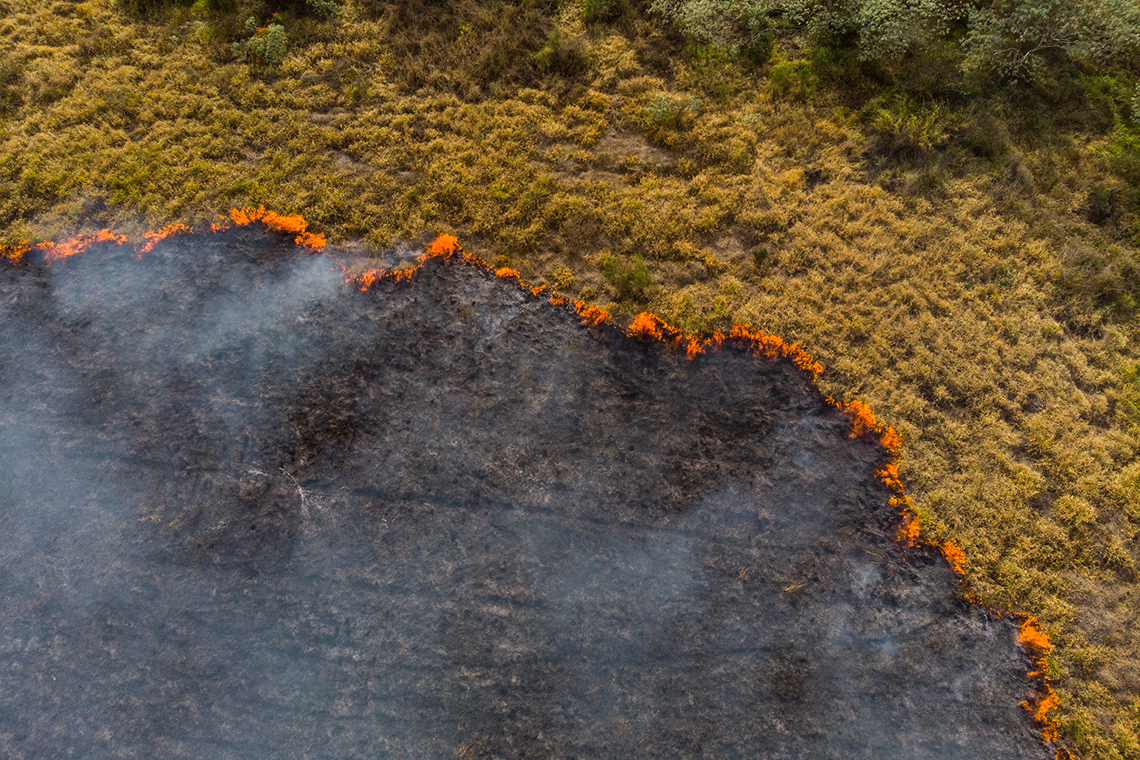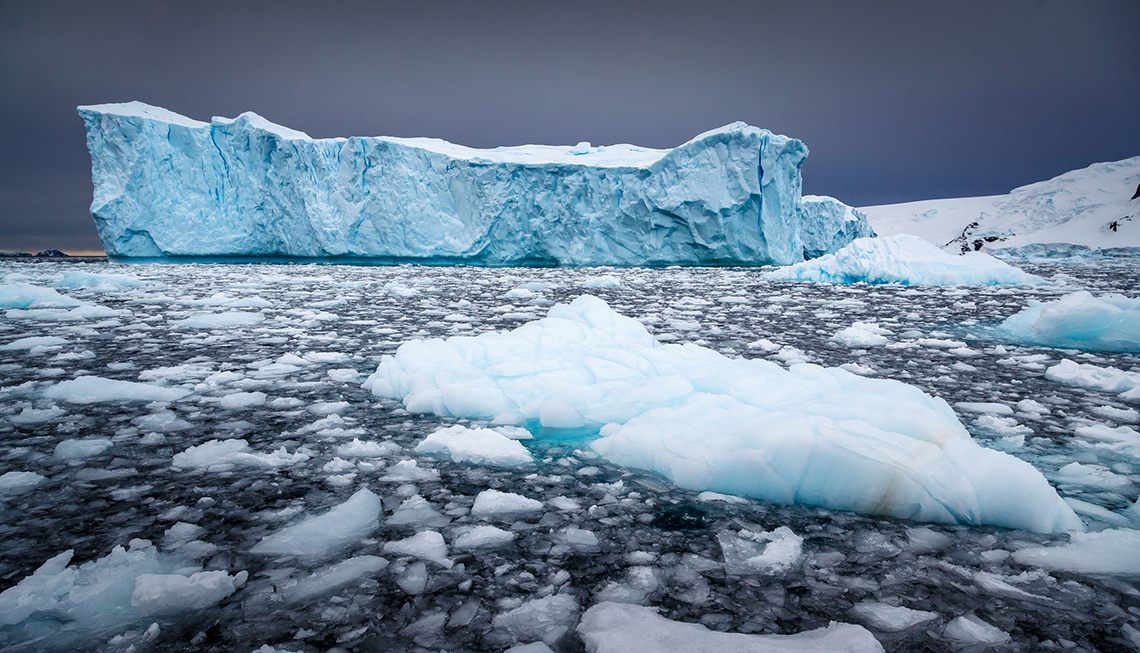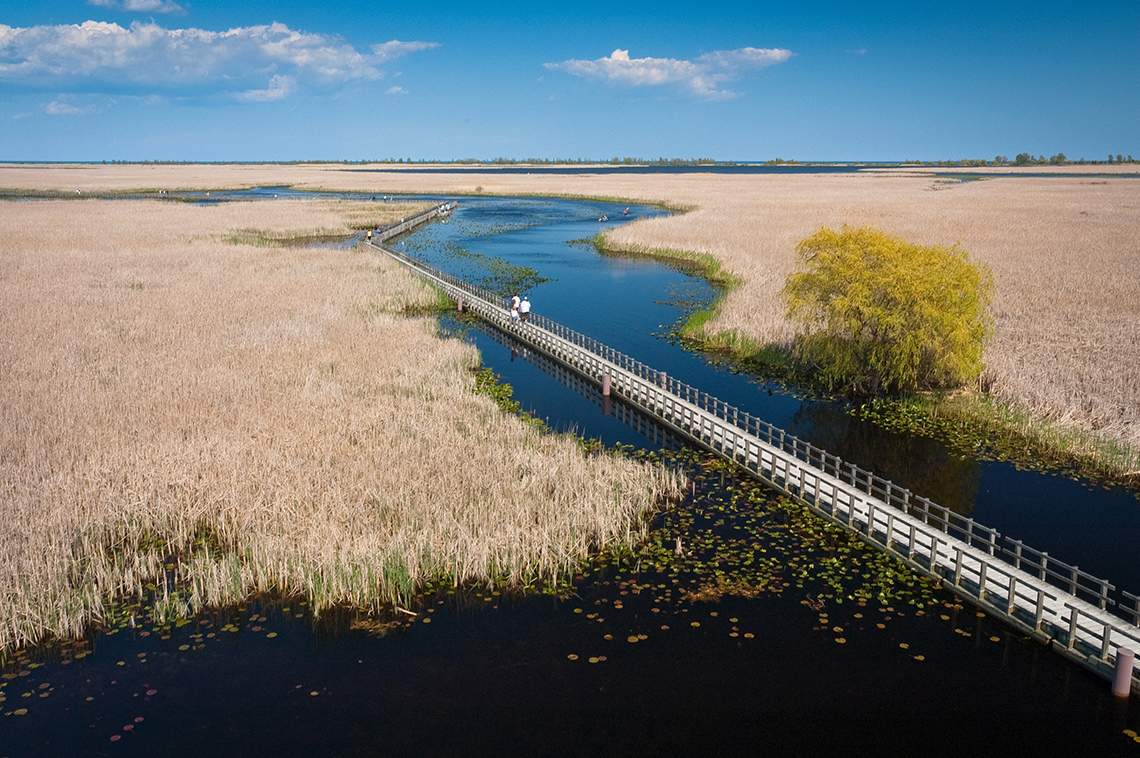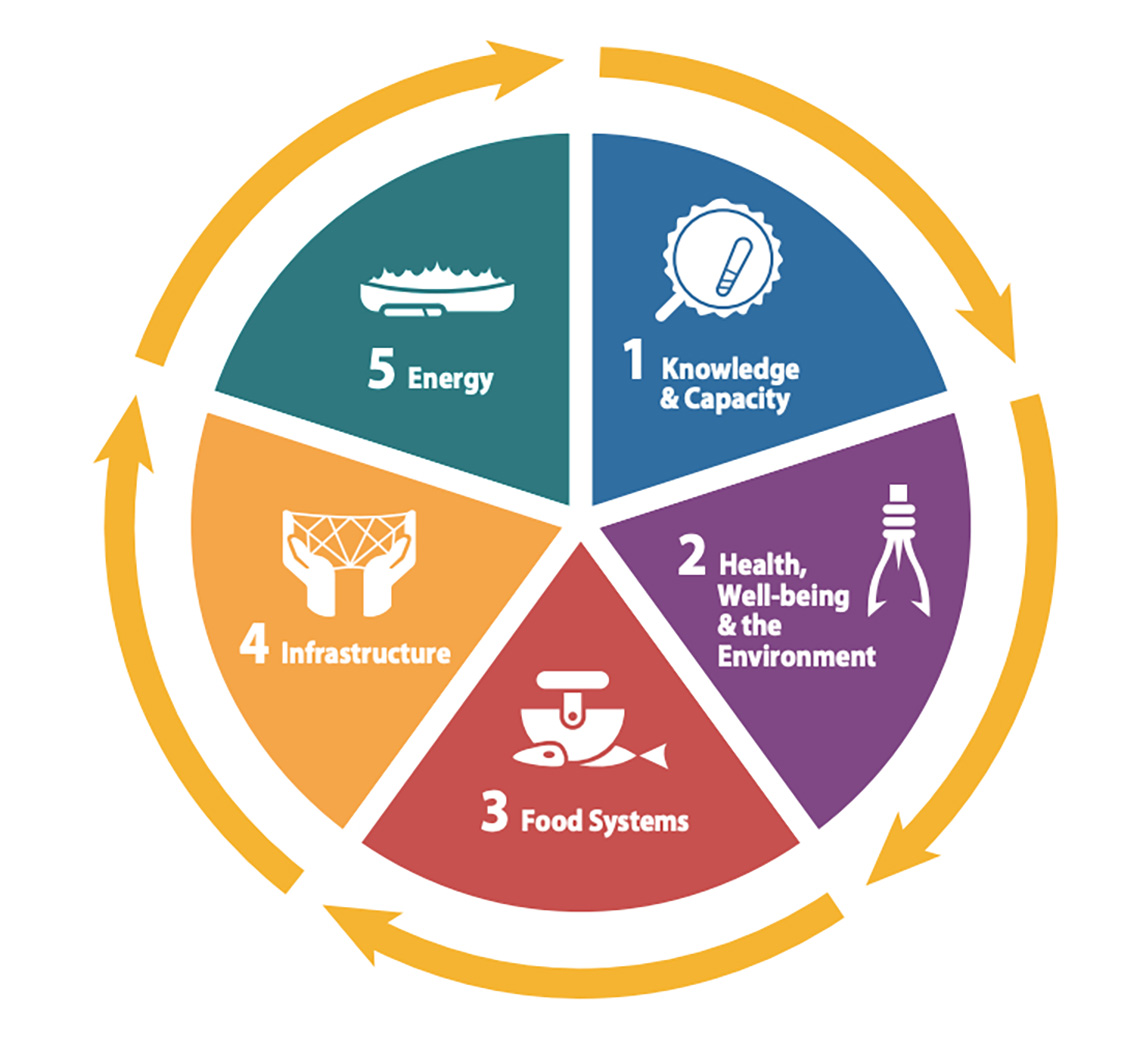Minds On
Ontario connection
This learning activity highlights people, places, or innovations that relate directly to the province of Ontario. Enjoy the exploration!

Explore the following image about the effects of climate change. Using the information provided, how do you think Ontario’s forests and lakes are being impacted by climate change? Record your response using a method of your choice.

The effects of rising global temperature include: stronger storms, rising sea levels, damage to corals, heat waves, wildfires, droughts, changes in animal migration, and changes in plant lifecycles.
Action
What is climate change?
Climate change is characterized by an alteration in global or regional climate patterns. The Earth’s climate has changed several times since it was formed several billion years ago. In more recent years, scientists have recorded irregular patterns in the Earth’s climate. As you can see in the infographic titled “Greenhouse Effect”, there are several factors caused by humans that are leading to an increase in Greenhouse gases in our atmosphere. Greenhouse gases trap heat from the sun into the Earth’s atmosphere, which then contributes to climate change.

When the Sun shines on Earth, some sunlight is reflected back to space by the atmosphere, some is absorbed at the surface, and some is reflected by the surface. The sun reflected by the surface is trapped in the atmosphere by greenhouse grasses. Some human activities that release greenhouse gasses into the atmosphere include: CFC's and haloalkane like refrigerators and aerosols, nitrous oxide from gasoline and agriculture, methane from cattle and fertilizer, and carbon dioxide from oil and coal.
In this learning activity you will be exploring how climate change is impacting Ontario forests and lakes and investigating nature-based solutions to climate change.
For this learning activity, you will need to know the following definitions.
Press the following tabs to access the definitions.
The establishment of a forest in an area where there was no forest previously.
The variety of organisms at all levels of classification and the variety of ecosystems within a specific geographic region and globally.
A forest, ocean, or other natural environment viewed in terms of its ability to absorb carbon dioxide from the atmosphere.
A thick subsurface layer of soil that remains frozen throughout the year.
A change in a given direction that causes additional change in the same direction.
Ontario forests
The impacts of climate change
Forests are natural habitats for plants and animals. Forests are affected by the impacts of climate change, such as: increasing air temperature, changes in seasons, and changes in precipitation (rain and snow) levels. Species that are equipped to handle the changing environment will survive, but other species will not which will impact the entire biodiversity of a forest. The key impacts of climate change on forests are:
- some trees grow faster, and others die sooner
- precipitation patterns can lead to drought which causes forest fires, or flooding which impacts a forest structure
- forests become less diverse which makes them more prone to pests
- the changes in the length of seasons impact the growth of plants, flowers, and germination which could lead to lower plant reproduction and growth

Indigenous communities and other communities that are dependent on forestry are impacted by the loss of forest ecosystems and timber supply. Some of these impacts push plants and animals outside of their natural habitat and are forced to adapt to changes in a new environment. Plants and wildlife rely on seasonal patterns, so when these patterns are disturbed, it can lead to “ecological mismatch” which disturbs migration patterns of birds and insect life.
Case study
Explore one example of an Ontario forest that is being impacted by climate change.

A map of Canada showing the location of the boreal forest. The boreal forest covers most of the country from west of the Yukon territory, across the majority of the Northwest Territories, a portion of southern Nunavut, and through the northern and central areas of British Columbia, Alberta, Saskatchewan, and Manitoba. Most of Ontario, Quebec and Newfoundland and Labrador contain the boreal forest. However, the boreal forest does not cover New Brunswick, Nova Scotia or Prince Edward Island.
Location: Boreal Forest Region, Northern Ontario
Issue: The Boreal Forest is warming faster than other regions in Ontario. Recent explorations of tree rings and wood density in the Boreal Forest suggests that there is a negative correlation between temperature and growth – the higher the temperature, the less the trees grow. 20% of the carbon storage is in the permafrost (underground layer of ice, rock, sand, and soil) that is below freezing, representing the largest carbon sink in the world. As the temperature rises, the Boreal Forest will suffer and invasive forest pests, such as the Siberian moth or Mountain Pine beetle, will spread quickly and kill some of the tree species. There is also a threat of forest fires as temperatures rise and there is a lack of rain. These forest fires would cause the permafrost layer to melt, releasing copious amounts of carbon at one time, emitting more carbon than it stores, causing further harm to the planet.
How is the Boreal Forest being impacted by climate change?
Nature-based solution
Nature-based solutions are actions that are used to protect, sustainably manage, and restore natural ecosystems while providing benefits for biodiversity. Nature-based solutions can be powerful tools in fighting against climate change by adapting to and mitigating the impacts of these global changes.
Forests need to be protected and maintained, when possible, restored when necessary, and created where needed. Here are a few examples of how Ontario forests are being protected:
- Provincial guidelines have been established that forest companies must follow, such as retaining trees used by wildlife during harvesting, creating a mix of tree species type and age, and ensuring that sections of the forest remain connected to maintain wildlife habitats.
- Afforestation is the conversion of unused land into forests, or the establishment of trees on land that has not been forested for at least 50 years.
- Assisted migration is the human-assisted movement of plants or animals to more climatically suitable habitats, generally northwards or to a higher altitude where site conditions may best suit their needs. This strategy can be used to maintain health and productivity and meet conservation goals to save a species from an increasingly unsuitable climate and habitat.
Select the correct answer, then press “Check Answer” to see how you did.
Ontario lakes
The impacts of climate change

Ontario lakes and rivers have been strongly affected by climate change. Warming air temperatures and incoming energy from the sun has created a “positive feedback loop” which isn’t so positive. A positive feedback loop accelerates temperatures rising which speeds up climate change. One example of this is sea ice; because it is white, it reflects more light than it absorbs, but increasing temperatures are melting the sea ice and exposing water, which absorbs the sunlight. This means more sunlight is getting absorbed instead of reflecting, which will continue to heat our planet, contributing to climate change. This increase in ocean temperatures will then lead to more melting ice, a greater ocean surface area, and more heat absorption – hence, a feedback loop.
Increases in temperature also disturb the nutrient cycling in water and cause it to constantly occur, which disturbs the ecosystem. This impacts water quality and prevents a variety of species from thriving in the water, including specific fish that thrive in cold water. Climate change increases the amount of nutrients, contaminants, salt, and minerals that are in the water as ice melts, which can be harmful to ecosystems and humans. As the water and species are impacted, so are human communities.
Nature-based solutions

One of the major nature-based solutions in protected lakes and rivers is to focus on wetland conservation and restoration. Wetlands are important ecosystems that include some of the most diverse habitats and a large range of biodiversity. Ontario’s wetlands provide precious ecosystem services that humans depend on for their health and wellbeing such as greenhouse gas sequestration, climate moderation, flood control, water quality, and general recreational value. The natural flood management services provided by wetlands is an important topic in the field of nature-based solutions. Wetlands can be a cost-effective complement to traditional infrastructure designed to protect communities from flooding while increasing grey infrastructure life cycle. By incorporating this natural infrastructure into flood and asset management plans, Ontario municipalities can plan for a future more resilient to increased flooding events.
Climate justice
Climate justice is “the fair treatment of all people and the freedom from discrimination in the creation of policies and projects that address climate change as well as the systems that create climate change and perpetuate discrimination.”
Climate justice emphasizes systemic change – new rules and regulations, public investments in infrastructure and better systems – above and beyond the small changes we can make as individuals. The two types of change are:
- Personal change – changes you can make in your own behavior to address climate change and reduce greenhouse gas emissions.
- Systemic change – changes in systems or our environment that address the underlying causes of climate change and high greenhouse gas emissions.
Explore two Indigenous communities working towards climate justice and addressing the systemic issues affecting their forests and waters.
Six Nations, Grand River, Ontario

A map of southwestern Ontario showing the Haldimand tract, a large piece of promised land centered along the Grand River. The tract begins north of Waterloo and passes south through Waterloo and Brantford. It empties into Lake Eerie. The tract is significantly larger than the reserve land of the Six Nations of the Grand River.
A map of southwestern Ontario showing the Haldimand tract, a large piece of promised land centered on the Grand River. Cities and towns on this tract of land include Brantford, Hamilton, Waterloo, Guelph and Richmond Hill. The tract is significantly larger than the reserve land of the Six Nations of the Grand River.
Source: Land Rights - Six Nations of the Grand River. (2022, December 19). Six Nations of the Grand River. https://www.sixnations.ca/key-issues/land-rights
The Indian Act
Before we get started, it is important to note that the word “Indian” is used in this section when referring to the Indian Act of 1867. Over time, several terms have been used to refer to Indigenous peoples. The original term, “Indian,” was replaced by the term “Aboriginal.”
Today, we use the term “Indigenous.”
Indian is a term that has been historically used to exclude and oppress Indigenous peoples. Due to the Indian Act, this term is still used by the government in official documents and is considered a legal definition used in Canada. Only use this term if it is a historical or legal reference. Although some Indigenous peoples still use this word as a term of reclamation, please note that this term is offensive when used by non-Indigenous people.
Six Nations of the Grand River are the caretakers of the Carolinian Forests and the Grand River. Six Nations is the largest First Nation in Canada and has over 27, 000 members, about half of which live on reserve.
It is a unique community because all six Haudenosaunee nations live in the same community. This includes the following nations:
- Mohawk
- Oneida
- Onondaga
- Cayuga
- Seneca
- Tuscarora
As unique as this community is, Six Nations, like all First Nations’ communities, are impacted by laws and regulations outside of their control. First Nations communities are governed by the Indian Act.
The Indian Act creates a unique set of challenges for First Nation communities as it prevents communities from owning their land (the reserve system) and governing their land in the ways that they see fit. Without land title or ownership, it is exceedingly difficult to secure loans for development and initiatives that would benefit the community.
The Indian Act also means that the funding and community infrastructure are federal responsibilities. Some of these responsibilities include setting up infrastructure for:
- education
- roads
- water
First Nations communities, as a result, lack the same access and funding as neighbouring non-Indigenous communities due to the restrictions within the Indian Act, which leads to systemic inequality and injustice in these communities.
Coupled with these issues are the effects of climate change which creates even more unmet social, housing, and energy needs within the community. Six Nations has communicated with the United Nations climate change organization to collect benefits of innovative development plans. They are applying to receive credits through the United Nations to fund climate change enhancement projects. For example, one of the projects involves a solar power plant to provide affordable energy to residents in the area. The overall aim of the project is to achieve affordable and clean energy for all residents. The goal of the Six Nations is to reduce emissions in their area and make significant contributions to climate change by preserving forests and natural resources.
Inuit Nunangat, Northern and Arctic Region, Canada
 Description
Description
A map of the Inuit Nunangat across the provinces and territories of Canada. The Inuvialuit territory covers a small portion of northern Yukon and the islands in the northern half of the Northwest Territory. The Nunavut territory is in Nunavut. The Nunavik territory covers northern Quebec. The Nunatsiavut territory is found in northern Labrador.
The Arctic is one of the first areas to experience direct, local levels of climate change. The Inuit who live in the Arctic, as well as Northern regions of Canada, recognize that their relationship with the environment has been profoundly altered by climate change and they need to play a key role in regulating the Earth’s climate. Through Inuit-led research and advocacy, they have been raising awareness about climate change for decades. Climate change is one of many stresses in Inuit Nunangat, the name for the Inuit homelands, where residents are experiencing hardships due to climate change, as well as social justice inequalities that have been going on for generations.
While address the social inequalities, the Inuit have also been documenting and sharing their knowledge of changing northern conditions including sea ice levels, bird migration patterns, mammal and fish migration patterns, and shifts in access to food. The environmental risk that Inuit are born into is intensifying because of climate change and they have been forced to alter their way of living (i.e., hunting strategies and seasonal activities) in response to these increased risks. Elders, Knowledge Keepers and community members are concerned about their ability to pass on knowledge to future generations when their way of life is increasingly unstable. For example, “sea ice is a fundamental source of food, learning, memories, knowledge, and wisdom”, but will soon, no longer exist (Indigenous Peoples Atlas of Canada).
Climate change has caused alterations to the natural environment (i.e., sea, lake, river ice loss, melting permafrost, shifts in water quality and availability, costal erosion, etc.) impacting existing infrastructure, which impacts Inuit culture, mental wellness, and livelihoods.
Press ‘Definition’ to access a definition of infrastructure.
Infrastructure is physical and organizational structures and facilities such as roads, buildings, power supplies, etc.
In the Arctic specifically, the Inuit are fighting to ensure that action is taken that will lessen the social and economic inequalities they face, and lead to a sustainable and climate-resistant community.
In Canada, there are 51 Inuit communities. The Inuit have already experienced first-hand the significant impacts of climate change impacts including loss of sea ice and the thawing permafrost. Inuit Tapiriit Kanatami (ITK), a non-profit organization that represents 65,000 Inuit, has developed an aggressive four-year plan to address climate change that is developed for, and by, Inuit communities.
The following graphic illustrates the interaction of these changes with existing inequities, such as access to traditional foods, cultural practices, safe and affordable housing, and health services.

A cycle moving from one priority to the next in the following order: Knowledge and Capacity; Health, Well-Being and the Environment; Food Systems; Infrastructure; and Energy.
These systemic inequities stem from the lasting impacts of colonization including the residential school system. This plan highlights Inuit strength and resilience and works towards addressing this climate emergency by focusing on Inuit self-determination in which research, action and partnership are all Inuit-led and driven by Inuit needs.
The strategy identifies five interrelated priorities for climate action, including to “improve Inuit and environmental health and wellness outcomes through integrated Inuit health, education and climate policies and initiatives.”
Pause and Reflect
Pause and Reflect
After exploring the information in this section about climate justice, how do you think climate change impacts communities differently?
Consolidation
Review your learning

Select the correct answer, then press “Check Answer” to see how you did.
Take action!

Reflect on the information you have learned and conduct your own brief research to brainstorm ideas for change. Use the following questions to guide you and record your thoughts in the organizer provided or using another method of your choice.
- How can you personally make a difference in fighting against climate change?
- What can your community do?
- What systemic changes do you think need to happen to create change?
Before beginning your research, explore this video that explains the scientific research process. This will help guide you as you work your way through this activity.
Check out this video to learn about the steps of the Scientific Research Process.
To help you brainstorm ideas, explore the following information:
Scientists have been warning for decades that increased average temperatures would lead to extreme weather events, such as immense flooding and out-of-control wildfires. Canada is currently facing a critical moment on climate. What does our country need to do immediately to create the decade of climate action we need?
Here are five critical steps we can start with, according to David Miller, former mayor of Toronto:
- Set a goal of reducing overall emissions by half by 2030, moving towards zero emissions by 2050.
- Cap oil and gas production. The industry claims that new technology can help reduce its environmental footprint — it is well past time for it to act.
- Provide access to clean electricity in all provinces of Canada. While there are some provinces that have access, others do not. All areas of Canada need to lead in creating a national electricity grid so that we can end energy generation through coal, oil, and natural gas.
- Increase support for the rapidly changing all transportation to electric models and the decarbonization of new and existing buildings.
- Provide new jobs and a proper transition support for those currently in the oil industry.
Complete the “Brainstorm Chart” in your notebook or using the following fillable and printable document. If you would like, you can use speech-to-text or audio recording tools to record your thoughts. Remember to use the information you read in this learning activity and information you gained in your own research.
| Personal / Community Level Changes | Systemic / Larger Global Changes |
|---|---|
Press the ‘Activity’ button to access Brainstorm Chart.
Reflection
As you read the following descriptions, select the one that best describes your current understanding of the learning in this activity. Press the corresponding button once you have made your choice.
I feel…
Now, expand on your ideas by recording your thoughts using a voice recorder, speech-to-text, or writing tool.
When you review your notes on this learning activity later, reflect on whether you would select a different description based on your further review of the material in this learning activity.